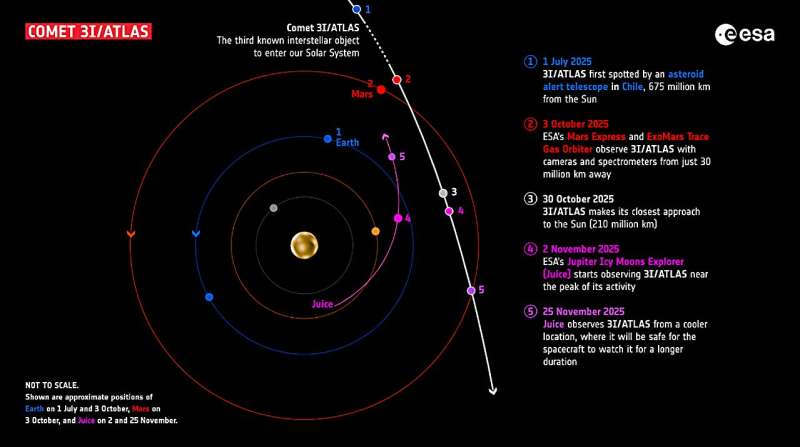The interstellar object 3I/ATLAS has been something of a mystery ever since it graced our solar system. From all outward appearances, the object appears to be a comet that originated in another star system and was ejected by gravitational perturbations. This was evident from the way it has been actively releasing water vapor as it draws closer to the sun, forming a coma and a tail. Nevertheless, it has exhibited some anomalous behavior, fueling speculation that it may be an interstellar visitor of another kind.
It is little wonder then why scientists and the general public have been hoping to get a closer look at 3I/ATLAS. There have even been proposals on how active missions could intercept the object to inspect it more closely. In the meantime, two Martian orbiters provided the closest view of the object: the European Space Agency’s (ESA) Exomars Trace Gas Orbiter (TGO) and the Mars Express. These two missions captured images of 3I/ATLAS with their dedicated cameras as it passed within 30 million km (18.64 million mi) from them.
The ExoMars TGO captured a series of images using its Color and Stereo Surface Imaging System (CaSSIS) while the Mars Express orbiter snapped pictures using its High Resolution Stereo Camera (HRSC). Both instruments are designed to photograph the surface of Mars, just a few hundred to a few thousand km below, when it is brightly lit. So naturally, there was uncertainty as to what these missions would capture from a relatively dim object millions of km away.
While CaSSIS could not distinguish the nucleus of the coma, being only 1 km (0.62 mi) in width and so far away, the coma itself is clearly visible in the image shown at the top. The full size of the coma could not be measured by CaSSIS since the gas and dust fade the farther it is from the nucleus. Since the tail extends an estimated 56,000 km (35,000 mi) behind the comet (based on recent images taken by the Gemini South telescope), it is much dimmer than the coma and therefore not visible in the CaSSIS images. However, it may become more visible as the comet approaches the sun and releases more material.
“This was a very challenging observation for the instrument,” said Nick Thomas, the Principal Investigator of the CaSSIS camera. “The comet is around 10,000 to 100,000 times fainter than our usual target.”
The Mars Express images have not yet captured 3I/ATLAS, as its camera has a much shorter exposure time of 0.5 seconds, compared to 5 seconds for the CaSSIS camera. Luckily, the mission scientists plan to analyze the data from both orbiters and combine their images to gain a more detailed view of 3I/ATLAS.

Meanwhile, Mars Express managed to collect spectra from the comet using its two spectrometers—Observatoire pour la Minéralogie, l’Eau, les Glaces et l’Activité (OMEGA) and SPectroscopy for Investigation of Characteristics of the Atmosphere of Mars (SPICAM)—and the TGO’s Nadir and Occultation for MArs Discovery (NOMAD) spectrometer. It is not yet clear whether the two orbiters gathered enough light for a proper characterization of the comet’s composition, but the mission teams will continue to analyze the data as the comet approaches the sun. Said Colin Wilson, a Mars Express and ExoMars project scientist at the ESA, said,
Though our Mars orbiters continue to make impressive contributions to Mars science, it’s always extra exciting to see them responding to unexpected situations like this one. I look forward to seeing what the data reveals following further analysis.
This coming November, the ESA’s JUpiter Icy Moons Explorer (JUICE) will be in a position to observe 3I/ATLAS after it makes its closest approach to the sun. The data will be available by February and is expected to reveal more about the comet, as it will be in a more active state. More detailed images and spectra will allow scientists to learn more about the comet’s composition, shedding light on its system of origin. Additionally, work is progressing on the ESA’s Comet Interceptor mission, scheduled to launch in 2029.
While not exclusively intended to study ISOs, this mission will be the first mission dedicated to exploring comets closely and obtaining high-resolution images and detailed information on their behavior and composition. It is also one of several concepts currently being explored by scientists who are hoping to get a closer look at interstellar visitors. Once it is placed in a parking orbit, the Comet Interceptor will wait until another long-period comet travels from the Oort Cloud towards the sun, or another ISO is detected entering our solar system. As Michael Kueppers, a Comet Interceptor project scientist, explained:
When Comet Interceptor was selected in 2019, we only knew of one interstellar object—1I/ʻOumuamua, discovered in 2017. Since then, two more such objects have been discovered, showing [a] large diversity in their appearance. Visiting one could provide a breakthrough in understanding their nature.
Given that comets and asteroids are essentially material left over from the formation of planetary systems, studying these objects is the next best thing to sending missions to distant solar systems. It is also considerably cheaper and faster, and is sure to provide valuable insights into other planetary systems in our galaxy within our lifetimes.
Citation:
ESA’s Mars Express and ExoMars orbiters catch a glimpse of 3I/ATLAS (2025, October 13)
retrieved 13 October 2025
from https://phys.org/news/2025-10-esa-mars-exomars-orbiters-glimpse.html
This document is subject to copyright. Apart from any fair dealing for the purpose of private study or research, no
part may be reproduced without the written permission. The content is provided for information purposes only.

